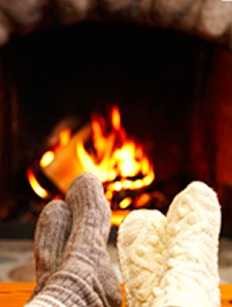Roasting by an Open Fire: Eco-Friendly or Health Threat?

A Tacoma-Pierce County WA Task Force just sent its recommendations to the Puget Sound Clean Air Agency about how to reduce soot in the air to meet EPA standards. The soot is created partly by diesel vehicles and industry, but the most (53%) is from wood burning stoves and fireplaces.
I remember from my days in New York City the ongoing struggle over fireplaces and the particulate pollution they create. The concern has spread nationally too. As the New York Times reported last January, sales of wood stoves and fireplaces have dropped dramatically over the last decade. The Times attributes this drop at least in part to the growing ambivalence towards wood fires.
But now that I’m in the Pacific Northwest, I find a different ethos about wood stoves and fireplaces. We feel good about burning wood; trees are abundant and so is firewood. We know instinctively that burning wood produces particulate pollution, we can see the smoke, but we also trust that the winter rains washes those particles away. Even some of our local experts see wood as a future fuel, a serious source of biomass energy. As University of Washington air-pollution researcher Michael Yost told KCTS 9, “We have a fuel that we can use which is relatively eco-friendly. It’s a renewable resource. So there’s a natural advantage to that biofuel use.”
But the realities and science of air quality question some of our long held assumptions about the wholesomeness of a fire. Yost explains, “…biofuels by and large across the world are much dirtier and have higher emissions. So we need to balance the use of these fuels versus the emissions they contribute. And probably starting on a local scale, because that’s where the problem starts.”
Seattle has not only experienced wood burning pollution but adopted curbs on residential wood burning. A 1985 smog problem so severe that the airport had to be closed was linked to residential wood stoves. Since then, “wood smoke in the Seattle area has been slashed by three-quarters or more, said Jim Nolan, executive director of the Puget Sound Clean Air Agency.” Burn bans that are announced and enforced have “cleared the air.”
Tacoma, a sister city to the south, continues to suffer in winter under sunny, cold conditions when atmospheric inversion traps the pollution close to the ground. Under these conditions, Tacoma often fails to meet the federal health standard for particulate pollution. Though levels of soot in Tacoma have stayed relatively constant since 2002, the EPA’s clean air standards have changed to address a wider range of health concerns. These new standards push the city out of compliance and require remedy.
In 1992, Washington required that all wood stoves sold be EPA Certified, which burn 60% cleaner; Washington State’s 1995 requirements are even tougher. To meet EPA emission standards and avoid penalties, Tacoma plans to mandate replacement of those older-model pre-1992 stoves by 2015. An estimated 24,000 old, heavily polluting wood stoves currently fall short of emissions standards; 15,000 are targeted for replacement.
But the task is gargantuan in these tight times: Officials say the cost for Tacoma could run $50 million or more, including incentives for certified wood stoves and installation that costs $2,000 each and tougher enforcement. Recommendations must be finalized by local agencies before the EPA deadline of December 2012.
There is some irony in the fact that the Pacific Northwest is a leader in developing cheap wood stove technology for less-developed countries in Southeast Asia, the Caribbean and Africa. The goal: 50 percent less fuel and 90 percent less emissions. These $25 super-efficient devices promise to eliminate 2 million deaths each year attributed to indoor smoke, more than AIDS or Malaria. Visiting a school on the LEWA Wildlife Conservancy a few years ago, I stood in one of these open-fire kitchens. It wasn’t long before my eyes burned and I couldn’t breath. Radha Muthiah, Director of the United Nations’ Global Alliance for Clean Cookstoves told KCTS 9 “The Pacific Northwest… has been a hub of research and for innovation that I would classify as socially related innovation.”
The EPA is identifying other localities in the Pacific Northwest and across the country whose wood burning heat is affecting air quality. Hopefully, the wood burning innovation for less-developed countries can be harnessed domestically for those who choose, for economics or aesthetics, to heat their homes by the power of a wood fire. A cheaper and cleaner wood stove would help Tacoma and the rest of us breath easier.


